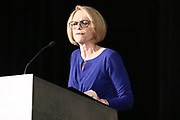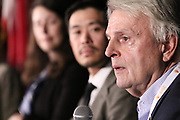The second day of the Social Determinants of Health (SDoH) Policy Forum featured five panel discussions on federal cross-sector partnerships, partnerships with health and social service providers, insights from the Congressional SDoH caucus, the latest national legislation related to SDoH, and federal incentives for cross-sector partnerships. Here is a recap of two of the sessions.
 The day began with an early-morning interactive roundtable breakfast sponsored by Walmart. The session featured a cross-stakeholder impact exercise that asked attendees to prioritize policies and projects.
The day began with an early-morning interactive roundtable breakfast sponsored by Walmart. The session featured a cross-stakeholder impact exercise that asked attendees to prioritize policies and projects.
 Ellen Fink-Samnick, chair of the RISE SDoH Community, then officially kicked off the second day of the conference with welcome remarks, noting that the discussions on Tuesday that focused on the whole-of-government and whole-person approaches to care are essential to move the needle forward on social determinants and health equity. “Frankly, nothing less will do,” she said.
Ellen Fink-Samnick, chair of the RISE SDoH Community, then officially kicked off the second day of the conference with welcome remarks, noting that the discussions on Tuesday that focused on the whole-of-government and whole-person approaches to care are essential to move the needle forward on social determinants and health equity. “Frankly, nothing less will do,” she said.
Federal cross-sector partnerships to address SDoH
 To further address the whole-of-government approach, the first panel featured representatives from the Department of Health and Human Services (HHS), Center for Medicare and Medicaid Innovation, USDA, U.S. Department of Housing and Urban Development (HUD), and Federal Communications Commission (FCC) who discussed cross-agency partnership that address health and wellbeing and efficient use of federal funds to improve SDoH. The discussion focused on SDoH priorities, including housing, broadband access, and nutrition security, and HHS’ work to ensure that all 11 of its operating divisions are focused on SDoH.
To further address the whole-of-government approach, the first panel featured representatives from the Department of Health and Human Services (HHS), Center for Medicare and Medicaid Innovation, USDA, U.S. Department of Housing and Urban Development (HUD), and Federal Communications Commission (FCC) who discussed cross-agency partnership that address health and wellbeing and efficient use of federal funds to improve SDoH. The discussion focused on SDoH priorities, including housing, broadband access, and nutrition security, and HHS’ work to ensure that all 11 of its operating divisions are focused on SDoH.
Richard Cho, senior advisor for housing and services, HUD, considers housing to be the most important social determinants. Housing, he said, determines all other SDoH as it is your location that provides access to food, nutrition, transportation, and jobs. Housing quality also can determine whether individuals are exposed to environmental hazards or if it lacks indoor air quality. “If you lack housing or have housing insecurity, your health is directly impacted. We wish we could prescribe housing to people to improve chronic conditions,” he said. Health care is listed as a priority in HUD’s strategic plan and Cho’s role is to work to better coordinate with other agencies to better coordinate the important role HUD plays in advancing health care. In recent years, the department has delivered COVID-test kids and vaccines to HUD assisted housing and is now in the process of how it can ensure that every person who lives in HUD assisted housing can access primary care and maternity care. It works with CMS to advise on how Medicaid can cover a range of wrap-around services related to housing. Its partnership with CDC has involved addressing lead in home, indoor air quality, and homelessness.
Dr. David Ahern, senior advisor, Connect2HealthFCC Task Force, FCC, emphasized the importance that broadband connectivity can play in health and across all activities of life. The multidisciplinary task force helps to inform the leadership of the FCC about emerging opportunities that link broadband and health. Through its work the task force has been able to evaluate the relationship to broadband and health conditions, like diabetes, cancer, and opioid use and opioid mortality.
The USDA recently held two major conferences about health and nutrition, said Alison Hard, senior policy advisor for the food and nutrition service, USDA. While people are familiar with the concept of food insecurity, they often don’t think about nutrition insecurity. Not all Americans have simple access to healthy food they need to thrive due to structural barriers, she said. As part an initiative to address nutrition security, the agency played a key role at the recent White House Conference on Hunger, Nutrition and Health and as a result, it received $8 billion in nongovernment funding commitments. “We are really determined not to let the work stop there,” she said, adding that the second event was its own event hosted in partnership with HHS, where they brought together members of the health care community and federal partners to address how they can better engage in nutrition work in health care.
Asked why the departments aren’t addressing the systemic issues that cause people to be hungry and not have housing, Cho said the major reason is due to food and housing scarcity. “We are operating in an environment of extreme scarcity,” he said. “For those of you who firmly believe housing, broadband, food, and nutrition is an important SDoH, if those things matter for health most, why do we severely underfund them in this country?"
Insights from the Hill: Congressional Social Determinants of Health Caucus

We also heard from the inaugural and bipartisan co-chairs of the Congressional Social Determinants of Health Caucus.
Senator-Elect Markwayne Mullin (R-OK), who served as the Congressional SDoH Caucus co-lead, said that he views SDoH from a rural perspective because he makes decisions based on where he was raised and his life experience. Rural areas face far different challenges than urban and suburban areas. The poverty rate is higher, the graduation rate is lower, the average trip to a rural hospital is between 30 and 90 miles, and the number of rural physicians has dropped 28 percent. When a rural area loses a hospital, it not only loses jobs, insurance rates go up for manufacturing companies. “People don’t realize this. So it’s a huge impact in our communities,” he said, adding that often rural areas get lumped into suburbs that may have a hospital three miles away. “One size will not fit all.”
His colleague and co-lead, Representative Cheri Bustos (D-IL), who is stepping down from office at the end of this term, said all members from Congress bring different personal experiences. She brings the perspective from downstate Illinois, where she lives in a town of 3,00 people. To better understand how hard it is for people to work to make a living to support their families, she launched “Cheri on Shift,” a job shadowing program. Through the program, she did different jobs, including processing carp from the Illinois River, changing bulbs on streetlights via a cherry picker 30 feet in the air, making wire and toys, “It’s a way members of Congress to have a better understanding of the people they represent,” she said.
As a result of the work on the caucus, she said they wrote the Social Determinants Accelerator Act of 2021. Despite her departure from Congress after 10 years of service, Bustos said she is confident that the work of the caucus will continue in her and Mullins’ absence. Indeed, she is hopeful that Mullin will get a caucus started in the Senate. “We have more work to do…And we need to make sure we get Senate representatives to help support the Social Determinants Accelerator Act,” she said. The legislation will allow grants to be assigned at a local level because communities know best what needs to be addressed.
U.S. Rep. Lisa Blunt Rochester (D-Del.), who will serve as the new co-lead of the caucus along with Rep. Tom Cole (R-Okla.), was unable to attend the conference in person but made remarks via a pretaped video. She said SDoH is a top priority and it’s vital to break down silos and come up with new and innovative solutions and policies to move the needle on outcomes. Rochester said the priorities of the caucus will be informed by the professionals and community members who know what’s needed.
